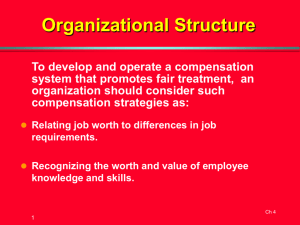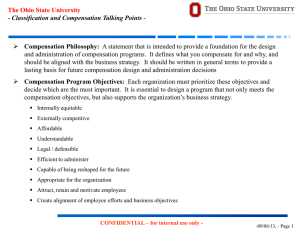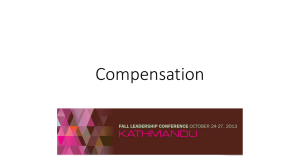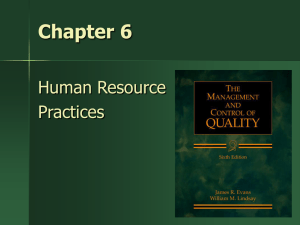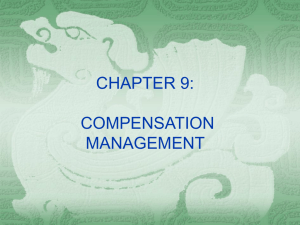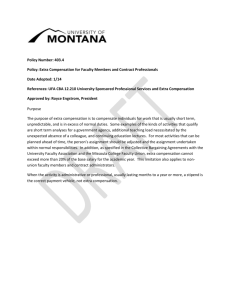Organization Structure: Strategic and Tactical
advertisement
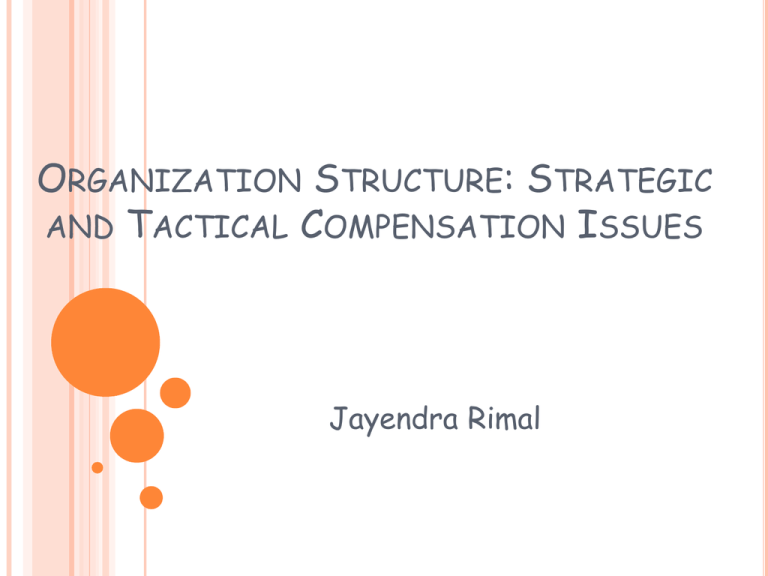
ORGANIZATION STRUCTURE: STRATEGIC AND TACTICAL COMPENSATION ISSUES Jayendra Rimal INTRODUCTION TO COMPENSATION STRATEGY Support organizational mission and strategy through compensation strategy and tactics that integrate major organizational groups of employees. It is necessary for organizational leaders to understand how strategy and tactics interact and become integrated. The compensation system must be transmitted in a manner that is understood and accepted by all employees that they are contributing to the success and the organization is willing to share the revenues in an equitable manner. SOME COMPENSATION STRATEGIES Relating job worth to differences in job requirements Recognizing the worth and value of employee knowledge and skills Rewarding employee contribution and results achieved Promoting continued employee acquisition and upgrading of knowledge and skills Supporting team and work unit efforts Design compensation plans that compete with the market Aligning compensation of all employees with objectives and goals of the organization Providing a compensation package that enhances current lifestyles and provided long-term protection to employees and their dependants. DEVELOPMENT OF AN ORGANIZATION Establishing a Philosophy Identifying the Mission Developing Policy Formulating Organizational Strategy Determining Goals and Objectives Defining Work Unit Activities Grouping Tasks into Jobs DEVELOPMENT OF AN ORGANIZATION The Philosophy – Many do not have written ones but it describes the values of the top management. Critical to organizational success is the degree of congruence between member’s and company vales. Mission – Describes in value-laden terms what the organizations hopes to accomplish in the long term and reasons for existence. Policy – Broad guidelines for directing actions. Strategy – This provides the foundation for future growth and development of the organization. It has to be realistic. Goals and Objectives – These are result oriented statements that make the transition from strategic to tactical operations through the most effective and efficient means. Work Unit Activities – Necessary to develop unit level functional statements. This helps in integrating objectives with that of the units. Worker Tasks – Specific individuals are assigned identified tasks, duties and responsibilities. EMPLOYEES – A CRITICAL RESOURCE The quality and quantity of organizational output depends on the skills, interest and effort of employees. Some important relationships with respect to pay: Pay Satisfaction – Employees make decisions based on comparison with others, both in and out of the organization Job Satisfaction – Pay and job satisfaction, although different, significantly influence each other. Organizational Satisfaction – Some of the factors that promote this are security in employment, fairness in personnel decisions, accepting organizational philosophy Satisfaction here means fulfillment of an obligation; is individual based and is a dynamic process, not a thing. CREATING AN ORGANIZATIONAL HIERARCHY One approach to distributing rewards is to focus on the hierarchy – the higher the level, the greater the responsibility and higher the reward. Hierarchy is based on different levels within a company. Board of directors, senior management, operations managers (senior, midlevel and first-level), sales, professional, administrators and operative employees. Unlike employees compensation for BOD consists of fees for board meetings, annual retainer, acquisition of stock in company Senior managers comprise of CEO and other top executives. Compensation of senior managers relates to that of the CEO Operating Managers – Middle hierarchy and wide range of pay with hopes of promotion to senior manager level Sales Personnel – Responsible for sale of product or service. Five methods of pay: salary, sales commission, combination, salary and bonus, combination of salary, bonus and commission Professionals – Perform non-routine work requiring originality, discretion, innovative abilities and analytic skills. Compensation equivalent to middle level management or higher. Operative Employees – Those ate the lower rung. Starts from minimum. PAY RELATIONSHIP Pay Equity – fairness in pay is usually evaluated by asking – “ How well does my pay compare with that other employees of my unit and the organization”? But certain jobs pay better than other jobs with organizations differing in how much they pay they pay employees. This is the market-based economy. Pay Ratios – There must be a relationship between pay of all employees from top to bottom. Ratios of lowest to highest is 5:1; in the US it is much higher while in Nepal it is very high in some industries. ANY QUESTIONS?

